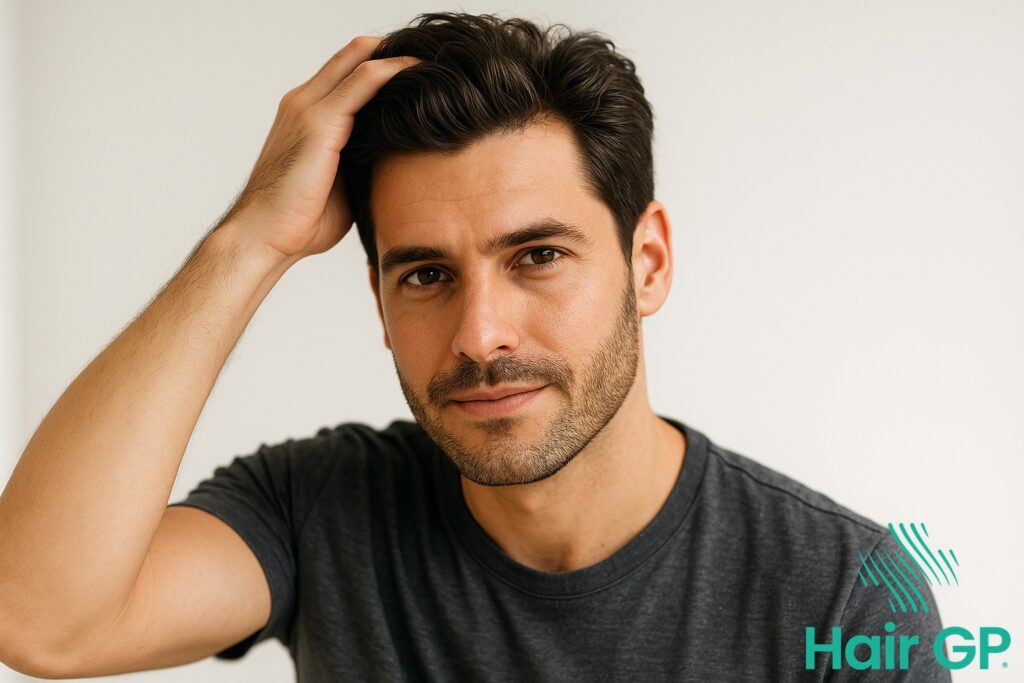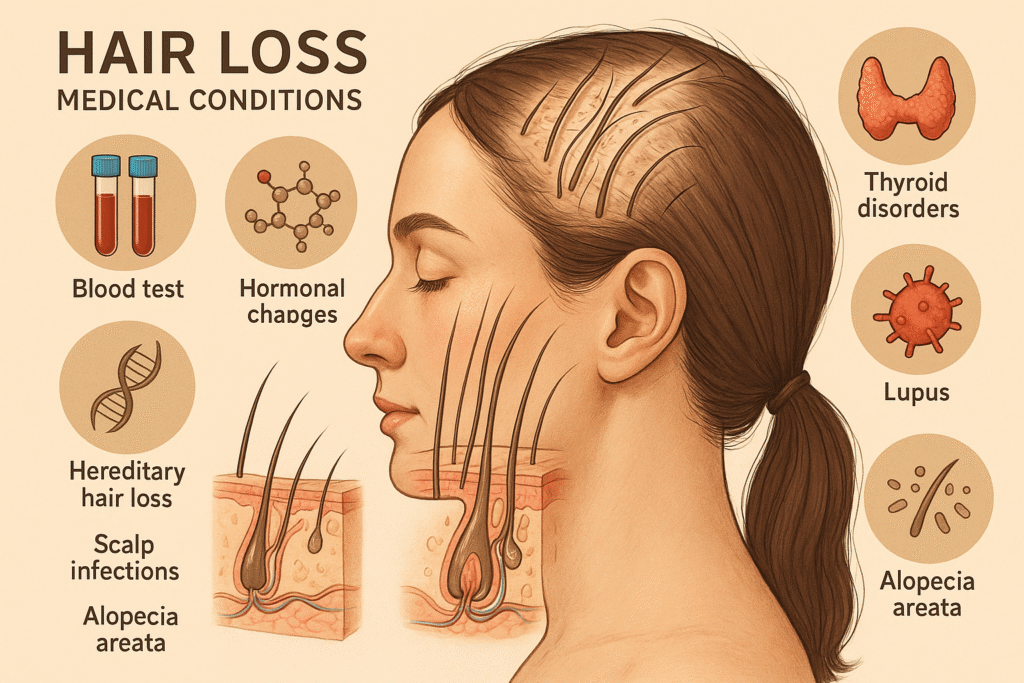Introduction
If you’ve noticed white flakes on your shoulders alongside thinning hair, you’re likely wondering: can dandruff cause hair loss? This common concern affects millions of people who struggle with both flaky scalp conditions and hair thinning simultaneously. While dandruff itself doesn’t directly cause permanent hair loss, the relationship between these two issues is more complex than many realize.
Understanding scalp health is crucial for maintaining strong, healthy hair growth. When your scalp becomes irritated, inflamed, or infected, it can create an environment where hair follicles struggle to function optimally. The constant itching associated with dandruff often leads to scratching, which can damage hair strands and potentially affect the hair growth cycle.
This comprehensive guide will help you understand exactly how dandruff and hair loss are connected. We’ll explore what causes those troublesome white flakes and examine whether they can truly impact your hair’s health. You’ll discover various scalp conditions that can trigger both dandruff-like symptoms and hair thinning, along with evidence-based treatment options that address both concerns simultaneously.
We’ll also cover the most effective products specifically designed for dandruff-prone scalps, helping you choose treatments that won’t compromise your hair’s strength or appearance. Additionally, you’ll learn when it’s time to seek professional help and discover practical prevention strategies to maintain optimal scalp health for years to come, ensuring your hair remains as healthy as possible.
This article is for informational purposes only and does not constitute medical advice. Always consult a qualified healthcare or medical professional before making changes to your health routine or starting any new treatments.
Key Takeaways – TL/DR
- Dandruff itself doesn’t directly cause permanent hair loss, but severe scratching can lead to temporary hair thinning
- Underlying scalp conditions like seborrheic dermatitis may contribute to both dandruff and hair loss
- Proper dandruff treatment with medicated shampoos can help maintain healthy scalp conditions
- Persistent hair loss with dandruff should be evaluated by a Specialist Hair Doctor
What Is Dandruff and How Does It Develop?
Dandruff is a common scalp condition characterized by the excessive shedding of dead skin cells, resulting in visible white flakes that appear on the scalp and hair. This condition affects nearly half of the adult population worldwide, making it one of the most prevalent dermatological issues [1]. Understanding the underlying mechanisms behind dandruff formation is essential for effective management and prevention.
The primary culprit behind most dandruff cases is a naturally occurring yeast called Malassezia, which thrives in oily environments. When this fungus proliferates on the scalp, it triggers an inflammatory response that accelerates skin cell turnover, leading to the characteristic flaky skin appearance. Fungal infections of this type are particularly common in individuals with excess sebum production, as the oily environment provides ideal conditions for Malassezia growth [2].
Additionally, dry scalp conditions can contribute to dandruff development through different pathways. When the scalp lacks adequate moisture, skin cells become brittle and shed more readily, creating white flakes similar to those caused by fungal activity. Both oily and dry scalp conditions ultimately result in the same visible symptom: persistent flaky skin that can be both embarrassing and uncomfortable for those affected.

The Direct Connection Between Dandruff and Hair Loss
The relationship between hair loss dandruff is often misunderstood, with many believing dandruff directly causes permanent baldness. In reality, dandruff creates conditions that can lead to temporary hair loss through mechanical damage and inflammatory processes affecting hair follicles.
Mechanical Damage From Scratching
An itchy scalp from dandruff triggers excessive scratching, which physically weakens hair shafts and damages follicles [3]. This mechanical trauma causes immediate hair breakage at the surface level, creating the appearance of thinning. Repeated scratching inflames hair follicles, disrupting their normal function and leading to temporary hair loss. The constant friction weakens hair structure, making strands more prone to breakage during normal activities like brushing or washing. However, this type of hair loss is typically reversible once scratching behaviors cease and inflammation subsides.
Inflammation and Hair Growth Cycles
Chronic scalp inflammation from dandruff disrupts natural hair growth cycles by affecting follicle health [4]. Inflammatory compounds interfere with the anagen (growth) phase, potentially shortening it and pushing more follicles into the telogen (resting) phase prematurely. This disruption manifests as temporary hair loss or diffuse thinning. Fortunately, hair follicles retain their regenerative capacity, and addressing underlying inflammation typically allows normal growth patterns to resume within several months.

Scalp Conditions That Cause Both Dandruff and Hair Loss
Several underlying scalp conditions can simultaneously trigger dandruff-like symptoms and hair thinning, creating a complex diagnostic challenge. These conditions share common inflammatory pathways that disrupt both the skin barrier and hair follicle function, requiring targeted treatment approaches.
Seborrheic Dermatitis
Seborrheic dermatitis represents the most prevalent skin condition causing both flaking and potential hair loss, affecting approximately 3-5% of the global population [5]. This chronic inflammatory condition creates persistent scalp irritation characterized by greasy, yellow scales and erythematous patches. The inflammatory cascade triggered by seborrheic dermatitis can weaken hair follicles through sustained cytokine release, leading to miniaturization and eventual hair thinning [6]. Unlike simple dandruff, seborrheic dermatitis involves deeper tissue inflammation that may progress to scarring in severe cases.
Fungal Scalp Infections
Fungal infections, particularly tinea capitis, create both scaling and patchy hair loss through direct follicle invasion. These infections typically present with circular patches of inflammation, broken hair shafts, and characteristic scaling. Other conditions like lichen planopilaris can mimic fungal infections while causing permanent follicular scarring. Unlike alopecia areata, fungal infections require immediate antifungal treatment to prevent permanent damage to affected hair follicles.

Effective Dandruff Treatment to Protect Hair Growth
Effectively treating dandruff requires a balanced approach that addresses symptoms while maintaining optimal conditions for hair growth. The key lies in using targeted treatments that eliminate flaking without compromising scalp health or disrupting the natural hair growth cycle.
Medicated Shampoo Ingredients
Medicated shampoos contain specific active ingredients designed to treat dandruff at its source. Zinc pyrithione reduces fungal growth and controls inflammation, making it highly effective for mild to moderate dandruff cases. Ketoconazole offers powerful antifungal properties that specifically target Malassezia yeast, the primary culprit behind dandruff formation. Selenium sulfide helps slow excessive skin cell turnover and reduces flaking while maintaining a healthy scalp environment that supports optimal hair growth conditions.
Proper Scalp Care Routine
Establishing a consistent scalp care routine is essential for long-term dandruff management and healthy scalp maintenance. Wash hair 2-3 times weekly with anti-dandruff shampoos, allowing the medicated product to remain on the scalp for several minutes before thorough rinsing. Incorporate gentle circular massage during washing to improve blood circulation and remove dead skin cells without causing irritation or damage. Follow with a lightweight, non-comedogenic conditioner to prevent excessive dryness while maintaining optimal scalp conditions. Consistency in this comprehensive routine ensures sustained results and prevents dandruff recurrence.
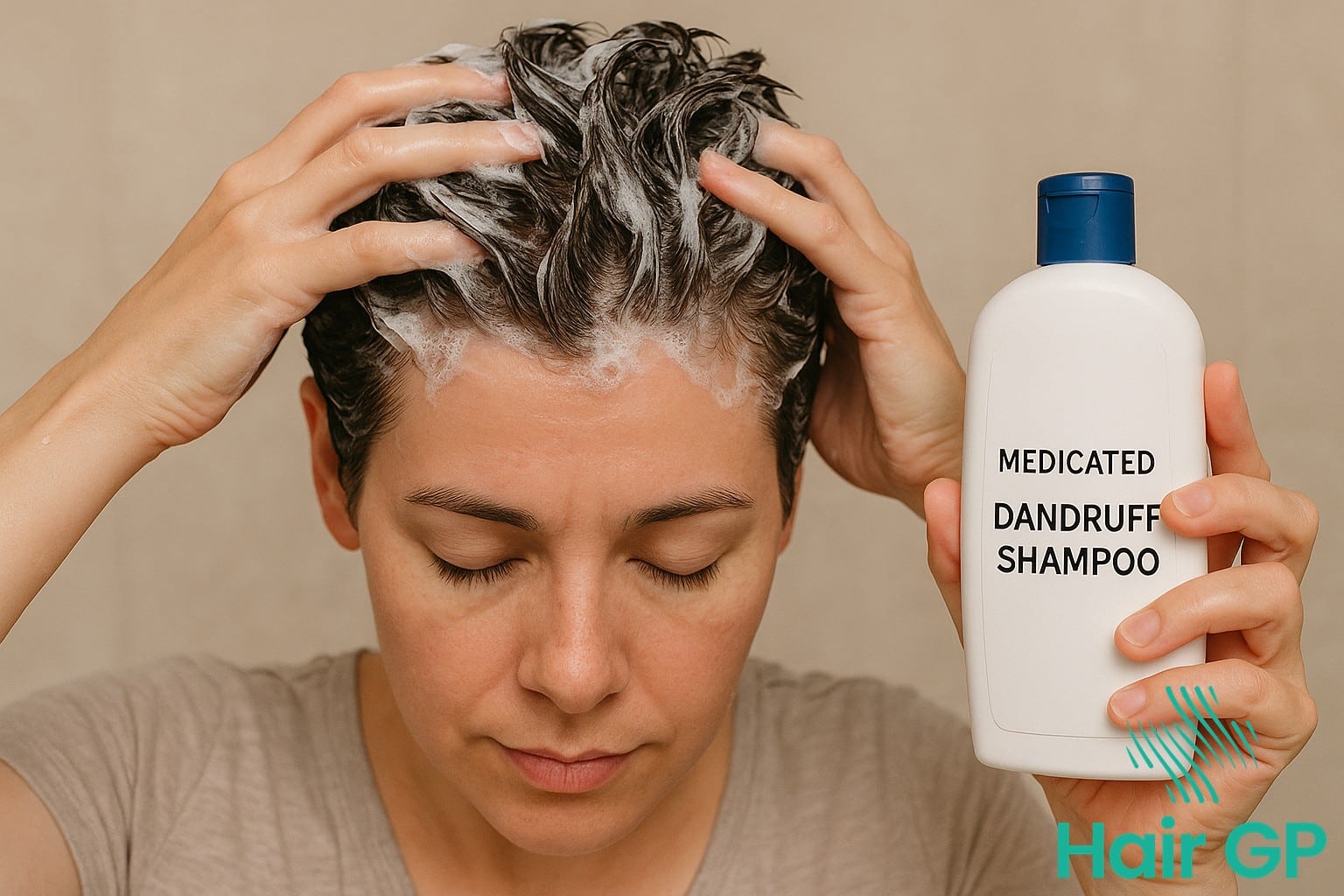
Best Hair Products for Dandruff-Prone Scalps
Selecting the right hair products for dandruff-prone scalps requires understanding which ingredients help control flaking without causing irritation. Dandruff shampoos containing active ingredients like ketoconazole, zinc pyrithione, or selenium sulfide effectively target the fungal overgrowth that causes scalp flaking. Nizoral, containing ketoconazole, stands out as a highly effective antifungal shampoo that reduces both dandruff and scalp inflammation when used twice weekly.
When choosing a conditioner, opt for lightweight, non-comedogenic formulas that won’t clog scalp pores or worsen buildup. Apply conditioner primarily to hair lengths and ends rather than the scalp itself. Avoid heavy styling products containing oils or waxes that can accumulate on the scalp and feed the yeast responsible for dandruff.
Look for shampoo formulations labeled “gentle” or “for sensitive scalps” if you experience irritation from stronger medicated options. Alternating between medicated and gentle cleansing shampoos can help maintain scalp health while preventing product buildup that might trigger flaking episodes.
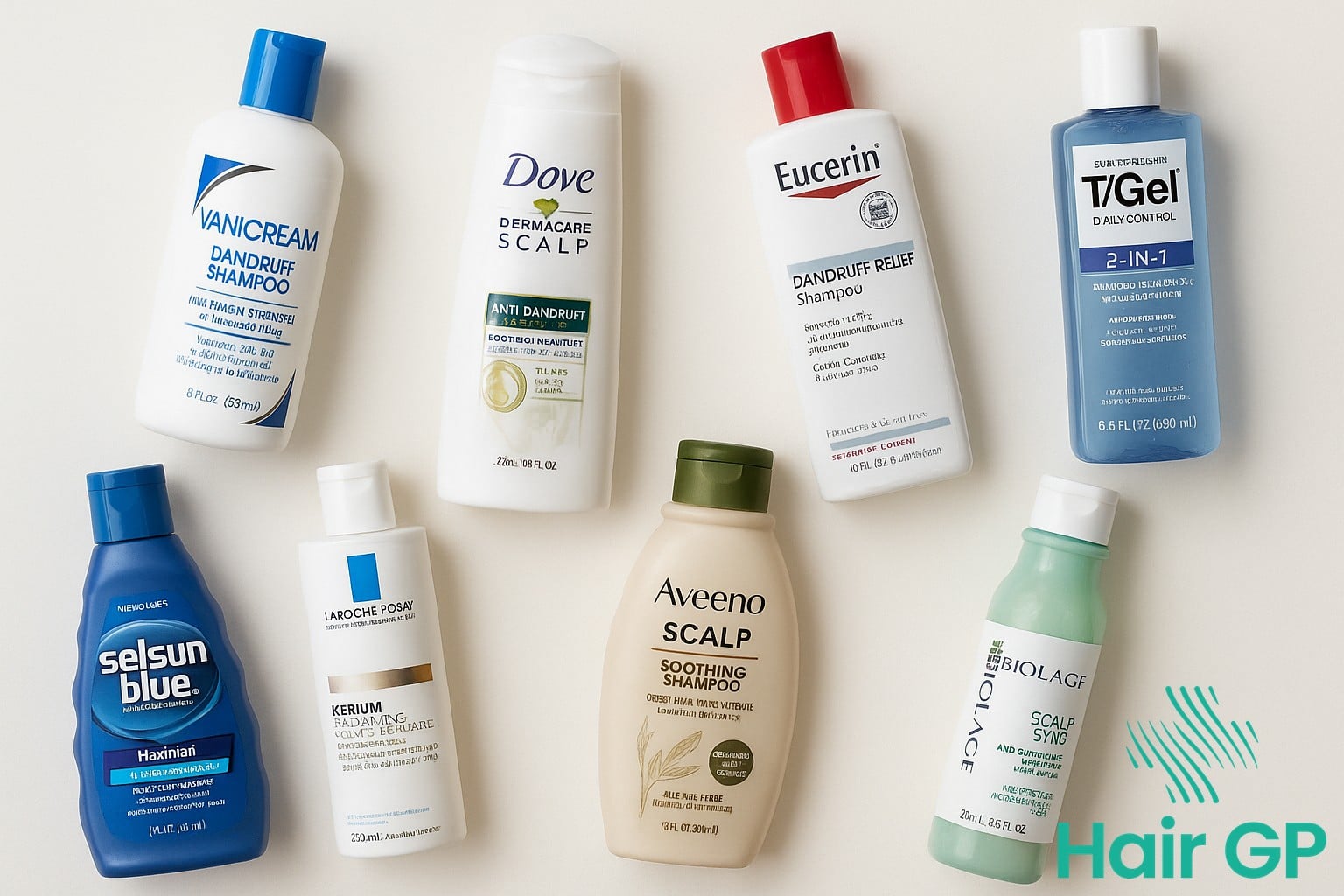
When to Consult a Doctor
Certain warning signs indicate it’s time to seek professional help from a Specialist Hair Doctor for your scalp health concerns. If you notice persistent dandruff that doesn’t respond to over-the-counter treatments after several weeks, professional evaluation becomes essential. When thinning hair accompanies severe flaking, itching, or inflammation, expert assessment can identify underlying conditions requiring specialized care.
Schedule an appointment if you develop a red, inflamed rash on your scalp, experience painful areas, or notice patches of significant hair loss. Symptoms resembling eczema, including persistent scaling and irritation, warrant professional attention. A specialist hair doctor can distinguish between common dandruff and serious conditions like seborrheic dermatitis that require prescription treatments.
Prevention Strategies for Long-term Scalp Health
Establishing consistent scalp hygiene practices forms the foundation of long-term scalp health and can effectively prevent hair loss. Regular shampooing with gentle, pH-balanced products removes excess oils and dead skin cells that contribute to dandruff formation while maintaining the scalp’s natural protective barrier. This routine supports natural hair growth by keeping follicles clear and healthy.
Environmental factors significantly impact scalp health over time. Protecting the scalp from excessive sun exposure, harsh weather conditions, and pollution helps maintain optimal conditions for hair growth. Additionally, managing stress through relaxation techniques and adequate sleep promotes healthy scalp circulation and hormone balance, both crucial for preventing hair loss.
Lifestyle modifications play a vital role in maintaining a healthy scalp ecosystem. Avoiding tight hairstyles that create tension on hair follicles, using clean pillowcases regularly, and minimizing heat styling damage preserves scalp integrity. Proper hydration and a balanced diet rich in vitamins and minerals naturally support scalp health and sustainable hair growth patterns.
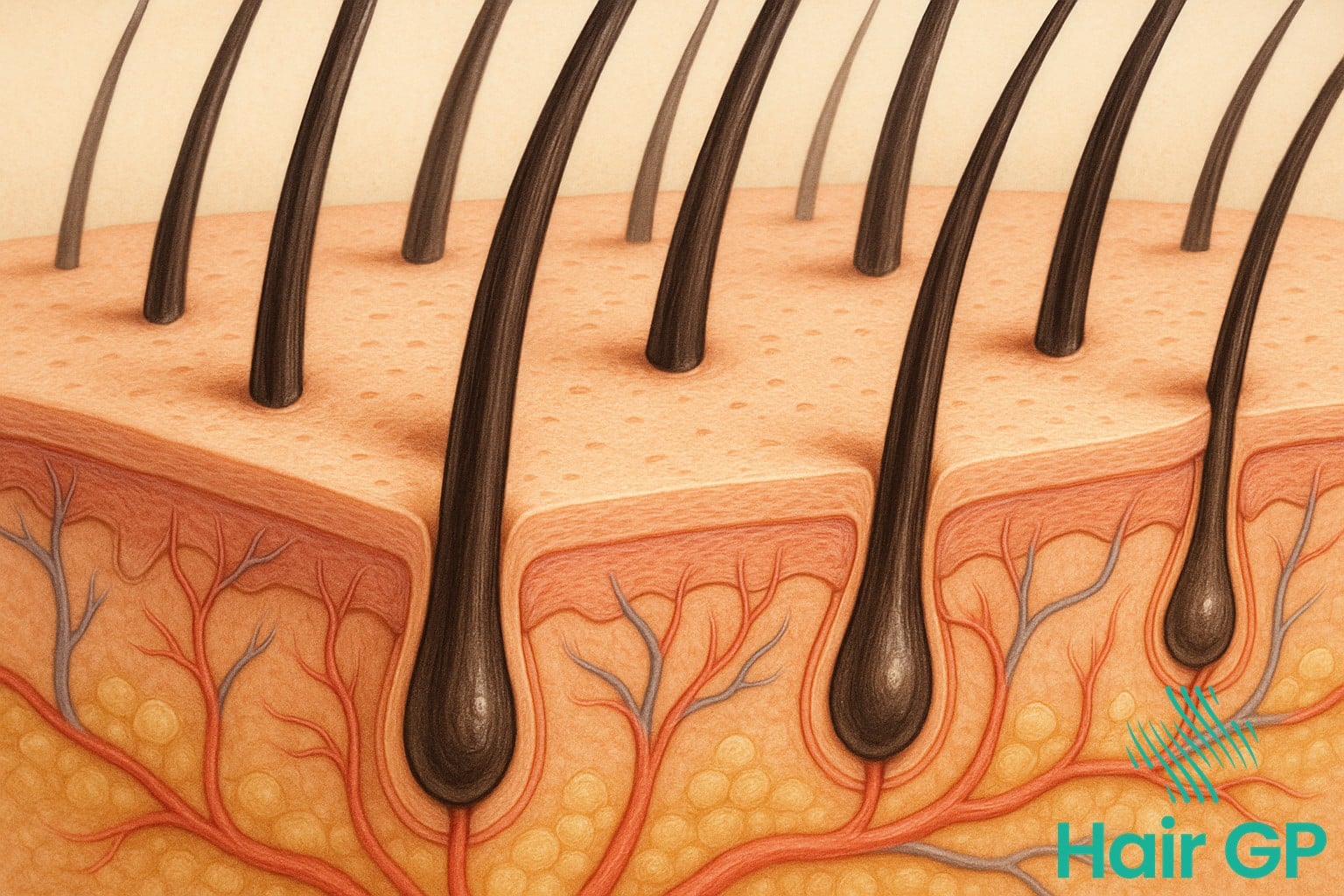
Conclusion
Understanding the connection between dandruff and hair loss is essential for maintaining optimal scalp health. While dandruff itself doesn’t directly cause permanent hair loss, the associated inflammation, excessive scratching, and disrupted hair growth cycles can lead to temporary thinning and breakage. The question “can dandruff cause hair loss” has a nuanced answer – it’s typically the secondary effects rather than dandruff alone that impact hair retention.
Fortunately, addressing dandruff through proper treatment can simultaneously improve hair growth conditions. Anti-fungal shampoos, gentle cleansing routines, and consistent scalp care create an environment where hair follicles function optimally. A healthy scalp provides the foundation for strong, resilient hair growth.
The most important takeaway is that both dandruff and related hair concerns are manageable with dedicated care. Establishing a consistent scalp health routine, using appropriate treatments, and avoiding excessive manipulation can restore balance to your scalp ecosystem. Remember that patience and consistency are key – improvements in scalp health and hair growth often take several weeks to become noticeable.
Frequently Asked Questions
No, dandruff itself does not cause permanent hair loss. However, excessive scratching due to itchy scalp can lead to temporary hair thinning and breakage.
Medicated dandruff shampoos can help maintain scalp health and reduce irritation, which may prevent temporary hair loss caused by scratching and inflammation.
If hair loss was caused by scratching or inflammation, hair typically begins regrowing within 2-3 months of successful dandruff treatment and proper scalp care.
Consult a Doctor if dandruff persists after 4-6 weeks of treatment, if you notice significant hair thinning, or if you develop severe scalp irritation or patches of hair loss.
References
- Saxena R, Mittal P, Clavaud C, Dhakan DB, Hegde P, Veeranagaiah MM et al.. Comparison of Healthy and Dandruff Scalp Microbiome Reveals the Role of Commensals in Scalp Health. Front Cell Infect Microbiol. 2018. PMID: 30338244
- Leung MHY, Tong X, Bastien P, Guinot F, Tenenhaus A, Appenzeller BMR et al.. Changes of the human skin microbiota upon chronic exposure to polycyclic aromatic hydrocarbon pollutants. Microbiome. 2020. PMID: 32591010
- Gavazzoni Dias MF. Hair cosmetics: an overview. Int J Trichology. 2015. PMID: 25878443
- Paus R, Cotsarelis G. The biology of hair follicles. N Engl J Med. 1999. PMID: 10441606
- Borda LJ, Wikramanayake TC. Seborrheic Dermatitis and Dandruff: A Comprehensive Review. J Clin Investig Dermatol. 2015. PMID: 27148560
- Dessinioti C, Katsambas A. Seborrheic dermatitis: etiology, risk factors, and treatments: facts and controversies. Clin Dermatol. 2013. PMID: 23806151




